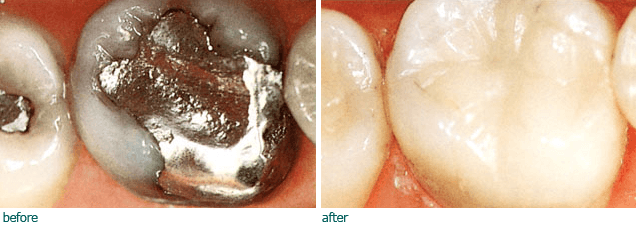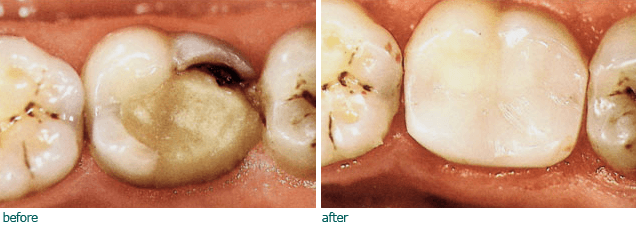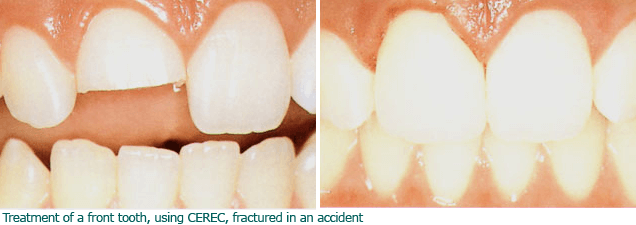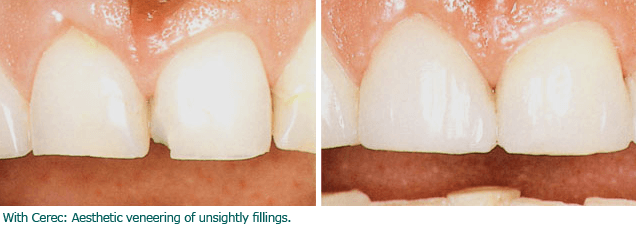Twisted crowded teeth
Although orthodontics is most often the best way to correct crowded teeth, it is not the only way. Less expensive and less time- consuming methods may be used if the problem is not too severe. Although the teeth may not be in perfect alignment, creating the illusion that they are may allow you to achieve your esthetic goal.
Crowded or crooked teeth may require a combination of techniques described below. Your ideal treatment, for example, may include orthodontics to reposition the teeth followed by bonding, veneers, or crowns to improve esthetics. The choice of treatment ultimately depends upon your commitment of time and money, as well as your dental and esthetic needs.
Cosmetic Recontouring
Cosmetic contouring is a simple and painless reshaping procedure in which tooth structure is contoured with finely ground diamonds. It’s used to improve the appearance of the teeth by giving the illusion of uniformity and alignment.
Although its simplicity generally makes it the most preferred therapy, cosmetic contouring is not right for everyone. Cosmetic contouring may be the best option if you:
- Have only slightly crowded teeth
- Do not wish to have an anesthetic administered
- Prefer a relatively inexpensive and quick procedure
- Agree with a compromise solution
Before selecting cosmetic contouring:
- Your dentist should evaluate the effect contouring may have on your teeth. Your bite must continue to be correct if the
- health of the teeth, as well as the proper distribution of pressure during normal oral functioning, is to be maintained.
- The thickness of the tooth enamel must be checked, the removal of too much enamel can expose the dentin, resulting in discoloration and possibly sensitivity.
- A conflict may arise between maintaining optimum function and achieving maximum esthetics. In these cases, the final decision should be based on a trade-off among esthetics, the degree of bite change, and the health of the teeth.
- A plaster cast may be constructed so that you can see the limitations in your particular case.
- Cosmetic contouring should not be performed on children’s teeth. It can cause slight sensitivity—not only during the procedure, but afterward—because they have a larger amount of sensitive pulp tissue.
Bonding–Quick compromise
If cosmetic contouring alone cannot shape up your smile, it can be combined with composite resin bonding to “build out” the fronts or backs of the teeth to fall in line with neighboring teeth. The result is an illusion of straightness that can be quite pleasing.
Orthodontics
Orthodontics is the treatment of choice when the top priority is keeping the teeth natural and unaltered. It is, without a doubt, the best way to correct malpositioned or crooked teeth. With orthodontic treatment, the teeth eventually will become aligned proportionally, making it your safest bet for a long-lasting, economical, and esthetic solution.
In years past, orthodontics was shunned by many adults because treatment was lengthy, and traditional metal braces were conspicuous and unattractive. Now dentistry has seen the advent of tooth-colored brackets, lingual (“behind the teeth’) braces, and removable appliances. The newest orthodontic treatment is “invisible” braces (such as invisalign), a series of clear, removable, transparent matrices that are changed every 2 weeks. Each matrix moves the teeth to a specific position according to the custom computerized plan until the ideal placement is achieved. Most minor crowding can be corrected in 4 to 12 months, while more complex problems can be resolved in 18 to 30 months. However, compliance in wearing the appliance approximately 22 hours a day is mandatory. Invisible braces are easy to maintain with proper home hygiene and require less time in the dentist’s chair since there are no wires or brackets to replace, making them a great option for adults. An added benefit is that, if advised by your dentist, you can place bleaching gel inside the matrices and bleach your teeth at the same time you are straightening them.
Occasionally, the orthodontist may recommend that a tooth or teeth be extracted prior to realigning the teeth to make space, particularly in case where crowding is causing bone loss between the teeth.
Porcelain Veneers
In many cases, porcelain veneers can also provide a reasonable compromise when you want to avoid orthodontic treatment. Crooked and crowded teeth laminated with porcelain veneers will usually give the result of a polished, natural looking smile.
Crowns
Crowns are another way to correct teeth. Although they may be more costly and time-consuming than most of the previously discussed cosmetic procedures, they can produce a more dramatic change and may be a preferable alternative, particularly when teeth are erupting, damaged, or receding at extreme angles from the root structure.
If you think you may want to crown your crooked teeth, it’s wise to spend a little extra money for a wax-up or trial smile. This will allow you to see the intended result before your natural teeth are prepared. You can make a serious mistake by crowning crooked teeth and thinking they will look terrific. You may not be happy with the result since the final crowns may be much thinner than your own teeth. In such cases, you will not only have lost the money spent on crowns, but you will probably end up undergoing the treatment you should have gotten in the first place-orthodontics.
Choose crowns with caution
Crowns have limited use for crowded and crooked teeth because the orientation of the teeth to be crowned must be aligned with the surrounding teeth. If they aren’t, the crowns won’t be able to compensate for the difference. In other words, the same problem that existed with the natural teeth may also exist with the crowns.
Tooth size is another major factor to consider because each tooth needs to be- or at least appear to be—proportional. The more teeth that are treated, the less obvious any distortions will be. If only one or two teeth are crowned, however, there may be a noticeable difference between the crowned teeth and the natural ones, depending on the space involved. Careful cosmeticcontouring of both the teeth to be crowned and the adjacent teeth may make the final result appear more harmonious in size.
| Cosmetic Contoring | Bonding | Porcelain Veneers | Crowns | Orthodontics |
| Treatment Time | ||||
| About 1 hour or less | 1-2 hours per tooth | 2 office visits; 1-4 hours each (more time needed for more extensive treatment) | 2 office visits;1-4 hours each for up to 4 teeth (more time needed for additional teeth or more extensive treatment) | 6-30 months, depending on amount of crowding and method selected |
| Maintence | ||||
| Brush and floss daily | Have a professional cleaning 3-4 times per yearEat wisely-bonded teeth can chip more easily than your enamel
Push floss in and pull it through teeth rather than popping it out See dentist for repair as necessary |
Have a professional cleaning 3-4 times per yearTake special care when biting into or chewing hard foods
Get yearly fluoride treatment Brush and floss daily Use a fluoride toothpaste and mouthwash as prescribed by your dentist |
Avoid biting down on hard foods and iceGet yearly fluoride treatments
Brush and floss daily Use a fluoride toothpaste and mouth-wash as prescribed by your dentist |
Brush and floss daily with special careHave a professional cleaning 3-4 times per year
Schedule adjustment checkups every3-4 weeks during treatment Wear retainers indefinitely, at least a few nights per week |
| Results | ||||
| Immediate reshaping of tooth structure, making crowded teeth appear to be the appropriate size and straighter | Straighter teeth in 1 office visit | A polished, natural-appearing result that can make teeth seem straighter and is more stain resistant than bonding | The best esthetic results in terms of reshaping teeth | Crowded and overlapping teeth can be straightened |
| Treatment Longevity | ||||
| Indefinte | 5-8 years | 5-12 years | 5-15 years (directly related to fracures, problems with tissues, and decay) | Generally permanent if retainer is worn at least a few nights per week |
| Cost | ||||
| £90 to £180 per arch | £150 to £180 per tooth (repairs may cost £145 to £180) | £400 to £600 per tooth | £400 to £600 per tooth | £1500 to £3500 depending on the number of teeth involved and the appliance used;lingual braces may cost up to £3000 more per arch |
| Advantages | ||||
| Less expensive than other forms of esthetic treatmentPermanent results
Immediate correction Minimum treatment time Generally painless; no anesthetic required |
Conservative (little or no tooth reduction)Less expensive than veneers or crowns
No anesthetic required Teeth appear and feel straighter |
Less wear and chipping than bondingExcellent bond to enamel
Minimal staining and loss of color or luster More proportional results due to lab construction Long-lasting results -Gum tissue tolerates porcelain well |
Teeth can be lightened to any shadeLess time required than orthodontics
Less staining than bonding Last longer than bonding or veneers Offer greatest opportunity to improve tooth form |
Straightens misaligned teethPermanent results for most people if retainers are worn
Little or no tooth reduction required Usually less expensive than veneers, crowns, or bonding, depending on number of teeth involved Improved tissue health due to better cleaning access following treatment |
| Disadvantages | ||||
| Does not reposition teethImprovement may be limited by functional considerations
Can cause discomfort for children with large pulp canals Does not improve color |
Does not reposition teethDoes not address gum inflammation due to crowding
Can stain or chip more easily than veneers or crowns May require frequent repair Teeth may appear and feel thicker |
More expensive than bondingDifficult to repair if the veneer cracks or chips
Margins may “wash out” and require repair |
Can fractureRequire an anesthetic
Not a permanent solution More expensive than contouring or bonding Irreversible Can trigger pulp irritation Can induce tooth sensitivity for a short time |
Time consumingTeeth may return to original position if retainers are not worn
May take a few weeks to get used to appliances Brackets can irritate soft tissue Thorough cleanings are more difficult during treatment |







